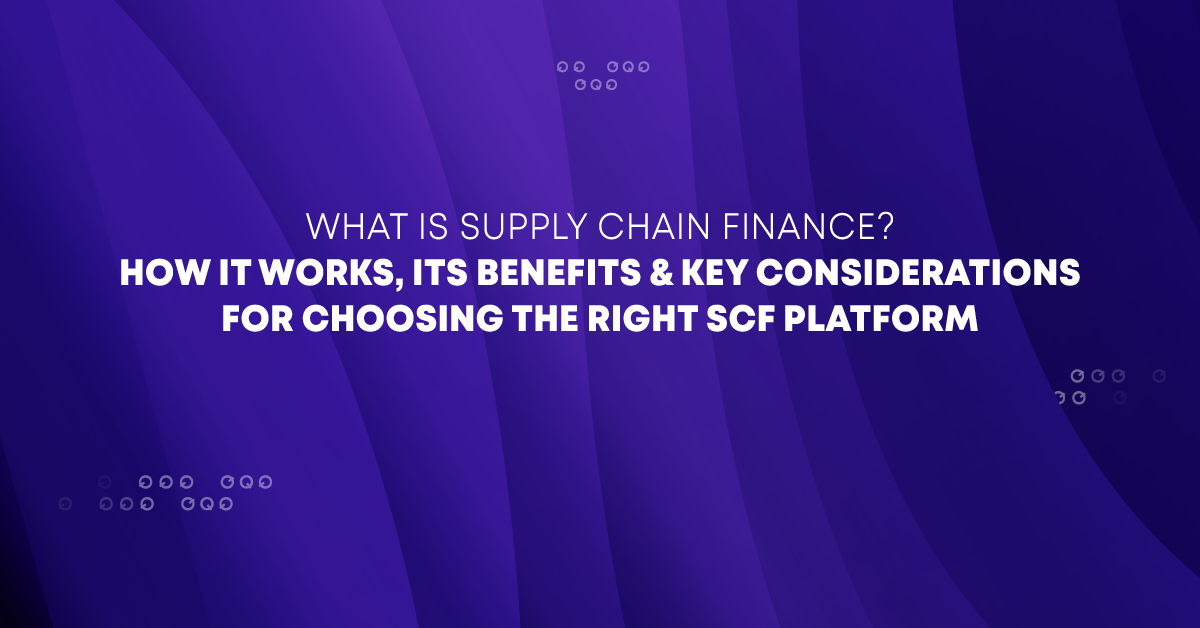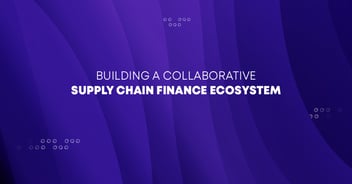1. Introduction
In the fast-paced business world, companies constantly seek ways to improve their operations, cut costs, and boost efficiency. One key factor in achieving these goals is effectively managing the movement of goods and services from suppliers to customers. This complex set of processes and transactions is commonly referred to as the supply chain. To streamline supply chain management, many companies are turning to a financial strategy known as Supply Chain Finance (SCF). In this blog, we will explore what supply chain finance is, provide an example of how it works in practice, discuss the many benefits it can bring to all involved parties and how to choose the correct SCF platform.
2. What is Supply Chain Finance?
Supply chain finance, also referred to as supplier finance or reverse factoring, is a financing solution that offers suppliers the opportunity to receive early payment on their invoices. By minimising the risk of disruptions in the supply chain, supply chain finance allows both buyers and suppliers to optimise their working capital. It involves a third-party financial institution, typically a bank or a specialised supply chain finance provider, facilitating early payments to suppliers on behalf of the buyer.3. How Supply Chain Finance Works
In a typical supply chain finance arrangement, several key steps, as described below, are involved, to create an efficient and mutually beneficial financial ecosystem within the supply chain:
- A buyer purchases goods or services from various suppliers. These suppliers can be smaller companies, and they often face cash flow challenges due to longer payment terms.
- The buyer and supplier agree on payment terms, which typically include a payment period (e.g., 60 or 90 days) after the delivery of goods or services. These terms may be dictated by the buyer and are often longer than what the supplier prefers.
- The buyer engages a financial institution or a supply chain finance provider to set up a supply chain finance program. The financial institution acts as an intermediary in this process.
- The supplier is invited to join the supply chain finance program voluntarily. If they choose to participate, they provide certain financial information and agree to discounted early payment terms offered by the financial institution.
- After the goods or services are delivered, the supplier invoices the buyer as usual.
- Instead of waiting for the standard payment terms, the buyer approves the invoice for early payment. The financial institution calculates the discount based on the agreed-upon terms and the remaining days until the original payment due date.
- The financial institution pays the supplier the invoice amount minus the discount. This provides the supplier with quick access to cash, improving their cash flow and reducing the need for external financing.
- On the original payment due date, the buyer pays the invoice amount in full directly to the funder, not the supplier. The buyer pays the financial institution the full invoice amount as originally agreed.
.png?width=664&height=347&name=SCF%20SEO%20Blog%20(3).png)
4. Supply Chain Finance Benefits
For Funders
- Profitable Returns: Funders earn fees or interest on the financing provided to suppliers, making supply chain finance a lucrative investment opportunity.
- Diversification: Supply chain finance allows financial institutions to diversify their portfolios and spread risk by funding a variety of businesses across different industries.
- Lower Risk: The involvement of reputable buyers in supply chain finance transactions reduces the risk associated with lending to suppliers, making it a relatively secure investment.
- Streamlined Operations: Automated supply chain finance platforms improve operational efficiency, reducing administrative overhead and processing costs for funders.
.png?width=638&height=334&name=SCF%20SEO%20Blog%20(5).png)
For Suppliers
- Improved Cash Flow: Suppliers gain access to quick, predictable cash flow by receiving early payments, reducing the need for costly short-term financing solutions.
- Lower Financing Costs: Supply chain finance often offers more favourable terms than traditional borrowing, helping suppliers reduce financing expenses and enhance profitability.
- Business Growth: Enhanced liquidity enables suppliers to invest in growth opportunities, expand production capacity, and take on larger contracts.
.png?width=571&height=299&name=SCF%20SEO%20Blog%20(1).png)
For Buyers
- Extended Payment Terms: Buyers can negotiate longer payment terms with suppliers, preserving their working capital for other strategic investments.
- Supplier Loyalty: Offering early payment options through supply chain finance can foster stronger supplier relationships and potentially lead to preferential treatment, competitive pricing, or priority access to goods and services.
- Risk Mitigation: By ensuring a stable supply chain and strengthening supplier relationships, buyers can reduce the risk of disruptions and delays, improving their overall operational resilience.
.png?width=581&height=304&name=SCF%20SEO%20Blog%20(4).png)
5. Choosing the Right SCF Platform
Choosing the right Supply Chain Finance (SCF) platform is crucial for effectively implementing and managing your supply chain finance program. Here are key considerations when selecting an SCF platform:
- Customisation and Scalability: Ensure the platform can be tailored to your specific needs. It should accommodate your unique supply chain, payment terms, and financial requirements. Additionally, verify that the platform can scale as your business grows.
- Ease of Integration: The platform should seamlessly integrate with your existing financial systems, Enterprise Resource Planning (ERP) software, and procurement tools. Compatibility ensures a smoother implementation process and ongoing operation.
- User-Friendly Interface: A user-friendly interface is essential for your team and suppliers. Ensure that suppliers can easily submit invoices and access payment status, while your finance team can manage transactions efficiently.
- Security and Compliance: Security is paramount. Verify that the platform adheres to industry-standard security protocols, including data encryption and user authentication. It should also comply with relevant financial regulations and data protection laws.
- Supplier Onboarding: Evaluate how the platform facilitates supplier onboarding. The process should be streamlined and user-friendly to encourage supplier participation in the program.
- Analytics and Reporting: Robust reporting and analytics capabilities are essential for monitoring the performance of your SCF program. The platform should provide real-time insights into cash flow, supplier participation, and ROI.
-1.png?width=847&height=155&name=SCF%20SEO%20Blog%20(2)-1.png)
6. Why QUALCO ProximaPlus
If you're looking for a top-notch platform for Supply Chain Finance (SCF), QUALCO ProximaPlus is the way to go. Its extensive range of features and capabilities makes it the perfect choice for adapting to various supply chain and financial requirements. ProximaPlus is customisable and scalable, ensuring that it can meet your needs.
It integrates seamlessly with user-friendly interfaces and robust security and compliance measures, ensuring a smooth and secure SCF program operation. Its supplier onboarding process is streamlined, making it easy for suppliers to join and use. ProximaPlus has advanced reporting and analytics capabilities, offering real-time insights for efficient program management. Additionally, it's known for its reliability, and forward-thinking technology, making it future-proofed for evolving SCF needs.
7. FAQ
Why is Supply Chain Finance Important?
Supply Chain Finance plays a pivotal role in modern business by optimising working capital, supporting supplier financial stability, reducing costs, mitigating risks, fostering collaboration, and providing a competitive advantage. It is a valuable financial tool that contributes to the overall efficiency and resilience of supply chains in an increasingly complex and interconnected world.
What’s the Difference Between Factoring and Supply Chain Finance?
Factoring and Supply Chain Finance (SCF) are distinct financial strategies with notable differences. Factoring begins at the supplier's initiation, with the factor assuming ownership of invoices and assessing the creditworthiness of the buyer's customers. In contrast, SCF is initiated by the buyer, who retains ownership of invoices and often relies on their own credit rating for assessments. The overarching purpose differs too: SCF aims to benefit both buyers and suppliers, fostering financial stability and stronger relationships, while factoring primarily serves suppliers in managing their cash flow.
What is Reverse Factoring in Supply Chain Finance?
Reverse factoring, also known as supply chain finance, is a financial arrangement that benefits all parties involved in a supply chain, including buyers, suppliers, and financiers. This mechanism is particularly useful for suppliers looking to improve their cash flow and receive early payment for their invoices.
How do Factoring and Reverse Factoring Differ?
Factoring and reverse factoring share the same concept and process but differ in initiation and credit impact. In reverse factoring, the buyer initiates early payment at the supplier's request, affecting the buyer's credit. In factoring, it's the supplier who initiates, affecting their own credit.
What's the Difference Between Supply Chain Finance and Trade Finance?
Supply Chain Finance and Trade Finance differ in terms of the parties involved and the nature of financial transactions. SCF is more collaborative, involving buyers, suppliers, and funders, with a focus on optimising working capital within the supply chain. Trade finance, on the other hand, primarily involves the buyer and a financial institution, with a focus on providing financing and managing risks associated with global trade through loans and credit facilities.



.png?width=352&name=Artboard%202%20copy%204%20(1).png)
